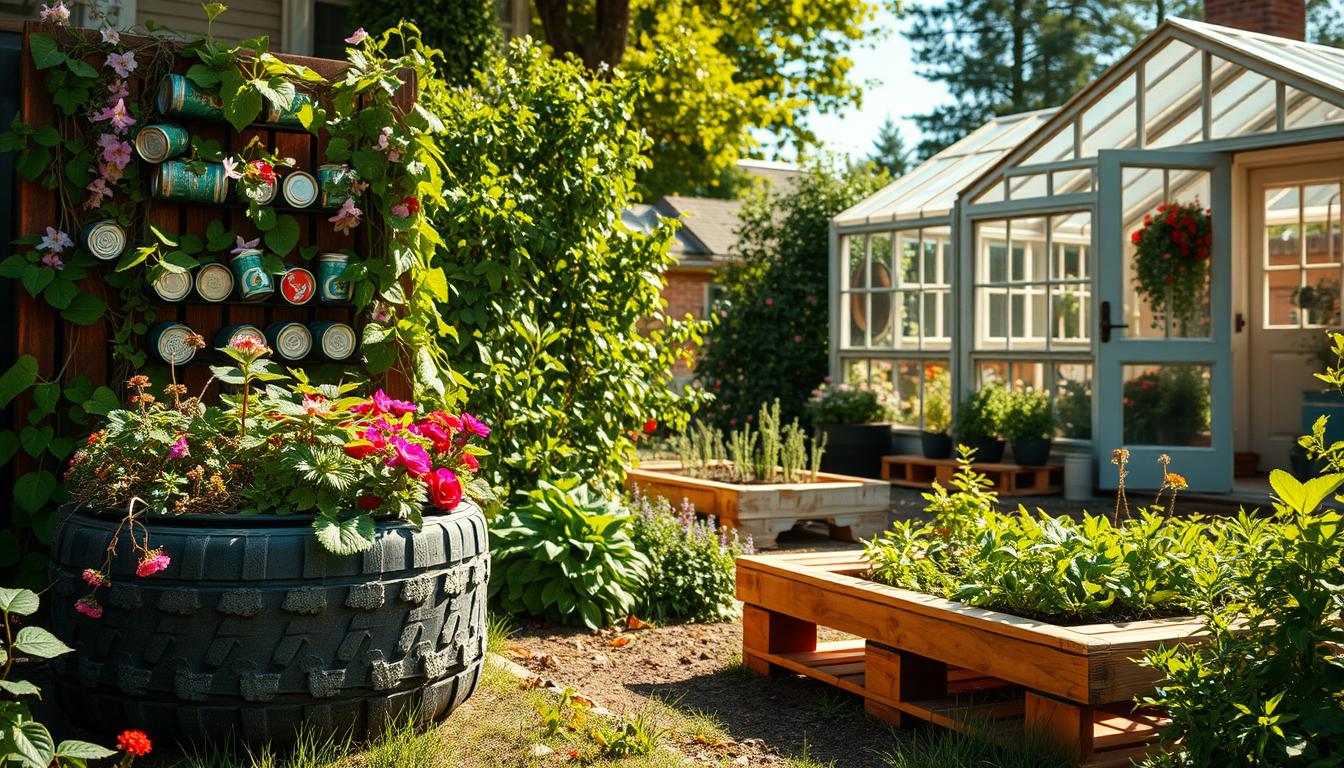Ready to give your outdoor space a fresh look? Sustainable gardening is all about creativity, caring for the environment, and saving money. By using reused items, you create beauty and help the planet.
Repurposed elements add a special touch to your yard. Old pallets become planters, glass bottles make colorful borders, and tires become flower beds. The options are endless.
You don’t need to be an expert to start. Whether you love plants or are new to outdoor projects, recycled garden materials are for everyone. They match today’s green awareness and let you express yourself.
In this guide, we’ll show you how to turn everyday trash into amazing garden features. Get ready to see your outdoor space in a new light. It will be better for your wallet and the planet.
The Growing Trend of Sustainable Gardening
In the United States, a green revolution is growing. Homeowners are now more into sustainable gardening than ever. Over 67% of gardeners think about the environment when planning their gardens, up from 35% a decade ago.
This change is happening everywhere. People in cities, suburbs, and rural areas are all getting into sustainable gardening. It’s not just a trend; it’s a movement.
More people see the good in eco-friendly landscaping. It’s not just about helping the planet. It also saves money. Garden centers are selling more native plants and organic materials, and social media is full of sustainable gardening tips.
Community gardens focused on green practices have doubled in five years. They’re places where people share knowledge and work together. Even commercial landscapers are now offering sustainable options to meet client demands.
Environmental Benefits of Eco-Friendly Gardening
Sustainable gardening does more than just make your garden look good. It helps the planet in big ways.
These gardens cut down on waste. They use materials that would end up in landfills. A single garden project can save up to 200 pounds of waste each year.
They also help fight climate change. Each square foot of a garden absorbs about 0.5 pounds of carbon dioxide every year. Plus, they use less water than regular gardens, saving this precious resource.
- Creates habitats for pollinators, with sustainable gardens supporting 3-5 times more beneficial insects
- Reduces harmful chemical runoff into local water systems
- Decreases air pollution through increased plant density
- Combats urban heat island effect by cooling surrounding areas
By living green in your garden, you help the environment. You support biodiversity and help your community reach its environmental goals.
Economic Advantages of Using Recycled Materials
Sustainable gardening also saves money. Homeowners who use recycled materials in their gardens can save 40-60% compared to buying new products.
For example, a raised garden bed made from reclaimed wood costs $25-35. That’s much less than the $150-200 for a new one. Using old containers for planters can save $75-100 each season. And making your own compost saves $40-60 a year on soil amendments.
Sustainable gardens also increase your home’s value. They can sell for 7-10% more than similar homes without them. This is based on real estate studies.
Maintenance costs also go down. Water bills can drop by 30-50% with smart water use. Native plants need less care once they’re established. Many gardeners save $200-300 a year on maintenance costs.
So, sustainable gardening is good for the planet and your wallet. It’s a smart choice that keeps saving you money season after season.
Understanding Recycled Garden Materials and Their Impact
Knowing what recycled garden materials are is key to a green garden. Using items that would go to waste helps our planet and saves money. These choices help reduce waste and save resources.
There are many types of recycled garden materials. Repurposed items, like old bathtubs as planters, are used in new ways. Upcycled materials, like wooden pallets turned into furniture, gain new value. Reclaimed materials, like parts from old buildings, are saved from being thrown away.
What Qualifies as Recycled Garden Materials
Recycled garden materials include a wide range of items saved from waste. They can be made from different materials and have been used before. Each type has its own benefits for gardening without waste.
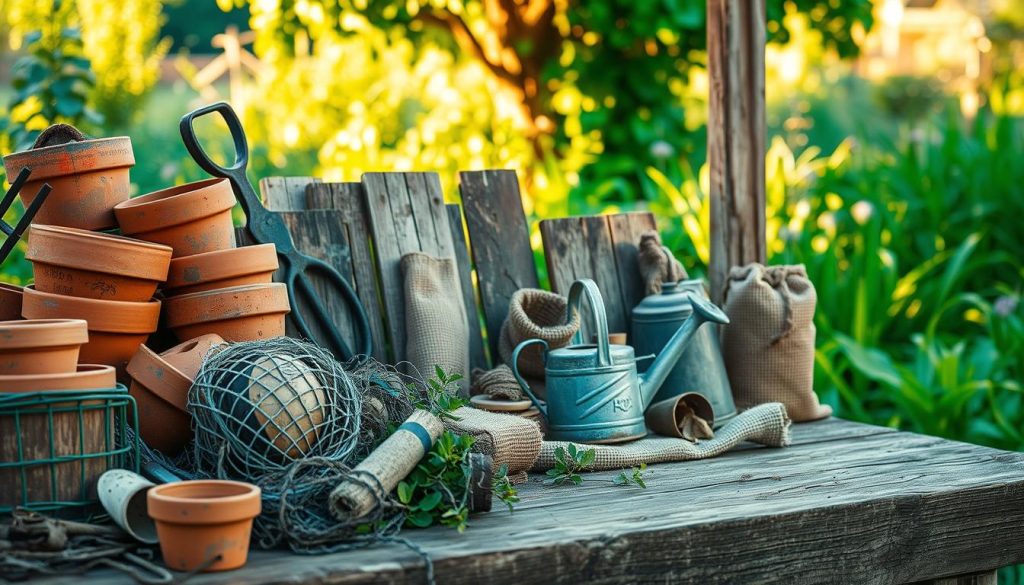
Wood items, like pallets and old furniture, are great for raised beds and trellises. Metal items, such as tin cans and tools, can be used as planters and garden art. Plastic containers from household items are good for growing seedlings and creating water systems.
Glass bottles and jars can decorate gardens, serve as mini greenhouses, or be garden art. Even things like newspaper and food scraps can be recycled as compost or mulch. It’s important to choose items that can handle the outdoors and don’t harm the soil.
Sources for Finding Repurposed Materials
Looking for quality recycled materials for your garden can be easy if you know where to look. Construction sites and demolition projects often have useful items like bricks and metal. Contractors might let you take these items to save on disposal costs.
Online platforms and local groups like Freecycle and Craigslist often have free or cheap materials. Thrift stores and garage sales are also good places to find unique items for your garden. Building relationships with local businesses can also help you find materials.
Evaluating Materials for Safety and Durability
Before using recycled items in your garden, make sure they are safe and will last. Avoid wood treated before 2004 because it may have arsenic. Look for stamps on the wood and avoid anything with a green tint or oily look.
Check metal items for rust and remove old paint to avoid lead. For plastic containers, check the recycling code on the bottom. Numbers 1, 2, 4, and 5 are safer for plants, while 3, 6, and 7 might leach chemicals.
| Material Type | Safety Considerations | Durability Factors | Best Garden Uses | Preparation Methods |
|---|---|---|---|---|
| Wood | Avoid pre-2004 pressure-treated lumber; check for chemical stamps | Hardwoods last 7-10 years; softwoods 3-5 years | Raised beds, furniture, borders | Sand rough edges, apply linseed oil or beeswax |
| Metal | Remove flaking paint; check for sharp edges | Galvanized lasts 15+ years; untreated iron 5-7 years | Trellises, art, structural supports | Remove rust, apply food-safe sealant if needed |
| Plastic | Use codes 1, 2, 4, 5; avoid 3, 6, 7 | UV-resistant types last 5-10 years; others 2-3 years | Containers, irrigation, seedling starters | Clean with vinegar solution, drill drainage holes |
| Glass | Check for cracks; smooth sharp edges | Indefinite lifespan if not broken | Decorative elements, mini greenhouses | Sterilize with boiling water or alcohol |
Cleaning and preparing items before using them is crucial. For items touching soil, clean with vinegar to remove contaminants. Adding drainage holes and sealants can make your recycled garden items last longer and stay safe.
Transforming Your Garden with Reclaimed Wood
Using reclaimed wood in your garden lets you create unique spaces. This wood, salvaged from old buildings, has a rich history. It adds character that new wood can’t match.
Choose hardwoods like oak, cedar, and redwood for your garden. They resist rot and insects well. Pine and fir work too, if treated right. Always clean your wood first and check for nails or splinters.
Light sanding is needed to prepare the wood. This removes rough edges but keeps the natural look. For growing food, avoid wood treated with harmful chemicals. Look for “HT” marked pallets instead.
Creating Raised Beds from Old Pallets
Shipping pallets are a great source of free wood for your garden. They make excellent raised beds for growing veggies, herbs, and flowers. These beds also keep your garden tidy and easy to access.
Make sure to use “HT” marked pallets for food gardens. They’re safe and the right size for easy planting and harvesting. One pallet can make a 3′ x 4′ bed.
Step-by-Step Construction Guide
- Disassemble pallets using a pry bar and hammer, removing all nails carefully
- Cut boards to desired length (typically 3-4 feet for manageable beds)
- Create a rectangular frame using the thicker support boards
- Attach slats vertically to the outside of the frame
- Reinforce corners with metal brackets or wood blocks
Finishing Touches for Longevity
To keep your beds in good shape, consider a few steps. Line the inside with landscape fabric to protect the wood from rot.
Use a food-safe sealant like raw linseed oil or beeswax on the outside. Add flat boards on top for seating. These steps can make your beds last longer.
Building Garden Furniture from Salvaged Timber
Reclaimed wood is perfect for outdoor furniture. It’s durable and adds a rustic touch. Simple benches are easy to make with just a few cuts and fasteners.
Start with a garden bench for beginners. Use thick timber for legs and decking for the seat. More complex projects include Adirondack chairs and picnic tables.
Focus on making your furniture strong and weather-resistant. Use stainless steel screws and galvanized brackets for safety and durability.
Decorative Elements Using Weathered Wood
Weathered wood adds beauty to your garden with decorative pieces. Make garden signs with plant names or quotes. The gray patina of old wood looks great with bright colors.
Build rustic trellises for climbing plants. They add interest and support vines. Use reclaimed wood to create clean borders and prevent soil erosion.
For unique garden art, arrange weathered wood into sculptures or mosaic wall hangings. The different colors and textures create beautiful, evolving artwork.
Creative Uses for Plastic Containers and Bottles
Your garden can help fight plastic waste by turning everyday containers into useful tools and decorations. Every year, millions of tons of plastic are thrown away in the US. By using these items in our gardens, we can reduce waste and make our outdoor spaces more interesting without spending a lot.
Zero-waste gardening is all about finding new uses for things others see as trash. With a little creativity and some basic tools, plastic waste can become a valuable part of your garden. Let’s look at some ways to give plastic containers a new life in your garden.
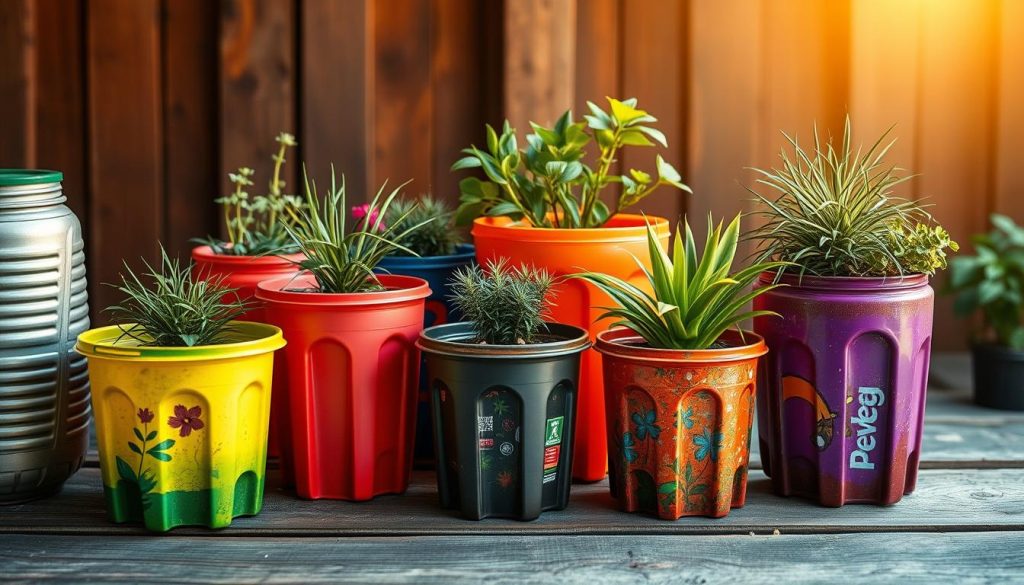
Innovative Planter Ideas
Plastic containers of all sizes are great for growing plants. From yogurt cups to laundry detergent bottles, they can become charming planters with a bit of effort. The trick is to choose the right container for the plant and add your own style.
Different containers suit different plants. Shallow ones like butter tubs are good for succulents and herbs. Deeper ones, like milk jugs, are better for plants with long roots, like tomatoes or peppers. Always drill holes in the bottom for drainage.
- Soda bottles – Cut horizontally for shallow herb gardens or vertically for hanging planters
- Detergent bottles – Their handles make them perfect for hanging gardens
- Food containers – Ideal for starting seedlings or growing microgreens
- 5-gallon buckets – Perfect for larger vegetables like tomatoes and peppers
Make plastic containers look better with non-toxic paint, decoupage, or natural materials like twine or burlap. These simple steps turn plain containers into beautiful DIY garden decor that fits your outdoor style.
Water Conservation Systems
Plastic containers are also great for saving water in gardening. They can be turned into efficient irrigation tools that save water and help plants grow better. Plastic’s tight seal makes it perfect for systems that capture, store, and distribute water where it’s needed.
These DIY solutions are often better than store-bought ones and help keep plastic out of landfills. With a small investment, you can set up a complete water management system for your garden using items you might throw away.
DIY Drip Irrigation
Make slow-release watering systems by drilling small holes in plastic bottle caps. Fill the bottles, screw on the modified caps, and bury them near your plants. The water slowly seeps into the soil, giving moisture right to the roots.
For bigger gardens, connect bottles with plastic tubing to make a large irrigation network. This is great for container gardens and raised beds where saving water is key.
Rain Collection Solutions
Larger plastic containers, like trash bins and storage tubs, are perfect for rain barrels under downspouts. Add a spigot at the bottom for easy water access and cover the top with mesh to stop mosquitoes.
For smaller spaces, use connected 2-liter bottles along a fence or wall. This system captures rainwater and adds a unique look to your garden. The collected water is great for houseplants and sensitive garden plants.
Garden Art from Plastic Waste
Plastic waste can also be used to create decorative elements for your garden. These artistic touches make your garden unique and keep plastic out of landfills.
Use colorful bottle caps to make mosaic stepping stones or garden walls. When arranged in patterns and set in concrete, they create durable, colorful surfaces that last outdoors.
Turn plastic bottles into wind spinners by cutting them into spiral strips. These catch light beautifully and add movement to your garden. For more practical art, make bird feeders from clear bottles by cutting openings and adding perches from dowels or twigs.
Make garden markers from cut-up plastic containers to identify plants. Write plant names with permanent markers or paint, and attach them to stakes for visibility. These waterproof markers last longer than paper ones.
Metal Recycling for Garden Structure and Decor
Metal waste can turn into amazing garden features. From old farm tools to kitchen items, they add durability and style. With a little cleaning and creativity, they become standout pieces in your garden.
Start by cleaning and smoothing out any sharp edges. For rusty items, you can remove rust or keep the weathered look. A sealant helps keep the metal looking good for longer.
Repurposing Old Tools and Farm Equipment
Old farm tools tell stories and add charm to your garden. Turn rakes into hanging planters or use tools as garden markers. Just add a name or a plant label.
Kitchen items like colanders and muffin tins make fun planters. Even old wheelbarrows and cans become beautiful container gardens. Rusty parts can decorate your garden walls or fences.
Creating Trellises and Plant Supports
Metal is strong, perfect for climbing plants. Bed springs and old bicycle wheels support vines beautifully. They grow right through the metal.
Use metal fencing or gates as trellises. Make sure they’re sturdy for your plants. For heavy climbers, attach them to posts or walls.
Decorative Metal Art for Garden Focal Points
Metal is great for garden art because it lasts and looks good. Wind chimes from old silverware add sound and beauty. Welded metal pieces create sculptures that shine and cast shadows.
Wind art moves and adds life to your garden. Even simple metal displays can be stunning. They become talking points and show off your creativity.
| Metal Item | Garden Application | Preparation Required | Durability | Visual Impact |
|---|---|---|---|---|
| Old Hand Tools | Plant markers, Small art pieces | Basic cleaning, Rust removal | 10+ years | Nostalgic, Subtle |
| Bed Springs | Plant supports, Trellises | Rust treatment, Securing | 15+ years | Industrial, Structural |
| Farm Equipment | Focal points, Large planters | Thorough cleaning, Edge safety | 20+ years | Bold, Statement-making |
| Kitchen Items | Small planters, Wind chimes | Minimal, Drainage holes | 5-10 years | Whimsical, Unexpected |
Working with metal has its challenges. You’ll need basic tools and plan carefully for heavy items. But, the results last a long time. Metal items can be permanent parts of your garden.
Upcycled Containers for Beautiful Planters
Upcycled planters give new life to old items, adding charm to your garden. They’re not just eco-friendly; they tell a story. These unique containers often cost nothing but bring a lot of personality to your outdoor spaces.
Turning everyday items into planters lets you show off your creativity. You can use anything from kitchen leftovers to vintage finds. These DIY projects are easy to do and make a big impact.
From Kitchen to Garden: Repurposing Household Items
Your kitchen is full of potential planters just waiting to be used. Old colanders are great for herbs because they have built-in drainage. Just line them with coconut coir and add soil.
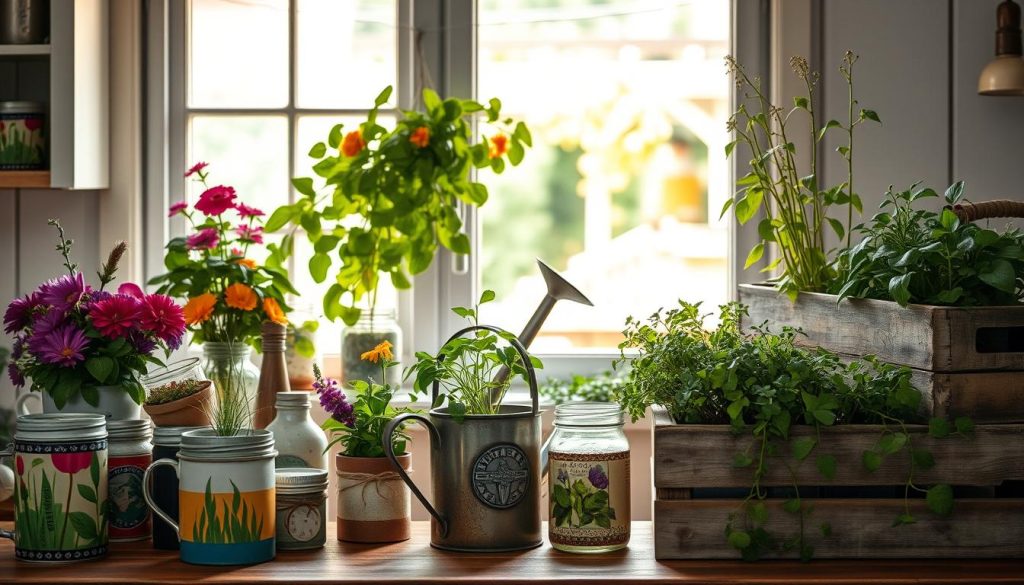
Even old kitchen appliances can be repurposed. An old blender is perfect for succulents, and large pots are great for veggies. For small plants, use food containers like yogurt tubs or coffee cans. Just remember to drill holes for drainage.
When picking items from your kitchen, choose ones that can handle the outdoors. Ceramic, metal, and sturdy plastic work well. Wooden items might need extra protection.
Vintage Finds as Character-Adding Planters
Vintage items make your garden unique. Old toolboxes and drawers are perfect for flowers or herbs. Their weathered look adds charm that new items can’t match.
Vintage suitcases can become stunning garden features. Just add plastic, holes for drainage, and soil. Small displays can use antique teacups, boots, or toys for succulents or small plants.
To keep vintage items looking good outdoors, seal wooden parts with waterproof sealer. Line fabric items with plastic. This keeps them looking great while protecting them from the weather.
Creating Vertical Gardens with Recycled Materials
Vertical gardens save space and show off your upcycled planters. They’re great for small gardens or balconies. Recycled materials offer endless ways to create living walls.
Vertical gardening is flexible. Start with a small wall feature or build a big living wall. Either way, it’s a great way to use space and reduce waste.
Wall-Mounted Systems
Turn ordinary items into amazing wall gardens. Shoe organizers become pocket planters for herbs and flowers. Old pallets make rustic living walls with lots of planting space.
Guttering and plastic pipes are perfect for wall-mounted planters. Attach them to your fence or wall, add holes for drainage, and fill with soil. For a unique look, use old metal items like mailboxes or tool organizers.
Freestanding Vertical Gardens
Freestanding vertical gardens add height and interest. Old ladders become multi-tiered displays with shelves or hanging pots. This lets you show off different plants and use space well.
Discarded shelving units and bookcases make great vertical gardens. Fill each shelf with different containers for a varied display. For a rustic look, use stacked crates or barrels to create a pyramid planter.
The Economic and Environmental Benefits of Recycled Garden Materials
Turning trash into garden treasures is more than just being creative. It’s a choice that saves money and helps the planet. Using recycled materials in gardening is a powerful way to live green. It offers big savings, less environmental harm, and stronger community ties.
Cost Savings Analysis
Using recycled materials in your garden can save a lot of money right away. A wooden planter box can cost $50-100 new. But, making one from reclaimed pallets might only cost your time.
Here are some cost comparisons for garden projects:
| Garden Element | New Materials Cost | Recycled Materials Cost | Potential Savings |
|---|---|---|---|
| 4’x8′ Raised Bed | $120-180 | $0-30 | $90-180 |
| Garden Bench | $150-300 | $15-50 | $135-250 |
| Trellis System | $75-150 | $0-25 | $50-150 |
| Garden Path (20 ft) | $200-400 | $0-75 | $125-400 |
Over a garden season, these savings can reach $500-1,000. As you get better at repurposing, your savings grow even more.
Reducing Your Carbon Footprint
Using recycled materials in gardening cuts down on environmental harm. Each item reused saves energy, cuts emissions, and keeps waste out of landfills.
The carbon savings are huge. A recycled wooden pallet can save 5-10 kg of CO2 compared to new lumber. Using 10 recycled containers saves about 40-60 kg of CO2 that would have been made from new plastic pots.
Composting kitchen scraps in recycled containers boosts these benefits. A household can keep 500+ pounds of organic waste out of landfills each year. This prevents methane emissions and makes nutrient-rich soil for your garden.
Building Community Through Material Sharing
Recycled gardening also strengthens community ties. Material exchange networks help neighbors share resources, knowledge, and ideas. This reduces waste together.
Starting a neighborhood garden material swap is easy. Just create a social media group for locals to share materials or needs. Monthly swap events at community gardens or parks build friendships and share useful items.
These efforts lead to tool libraries and skill-sharing workshops. In Seattle, a neighborhood gardening network turned into a community garden. It now educates and provides fresh produce for local food banks.
These collaborative gardening efforts do more than help the environment. They build local strength, fight isolation, and show how gardening choices can change communities.
Sustainable Hardscaping with Recycled Materials
Paths, walls, and patios are key parts of your garden. Using recycled materials for these makes your garden both sustainable and stylish. These elements guide movement and create useful spaces. Reclaimed materials add a unique touch that new products can’t match.
Choosing sustainable hardscaping is good for the planet and your wallet. It can be cheaper than traditional methods and makes your garden stand out. The weathered look of recycled materials adds depth and interest.
Pathways and Patios Using Reclaimed Materials
Using recycled materials for paths and patios changes your garden and saves resources. Reclaimed brick, stone, tiles, and concrete are great for paving. They have a unique character.
Start with a level base of sand or gravel. Arrange your materials in patterns like herringbone or random mosaics. Use sand or gravel to fill gaps, or plant groundcovers for a softer look.
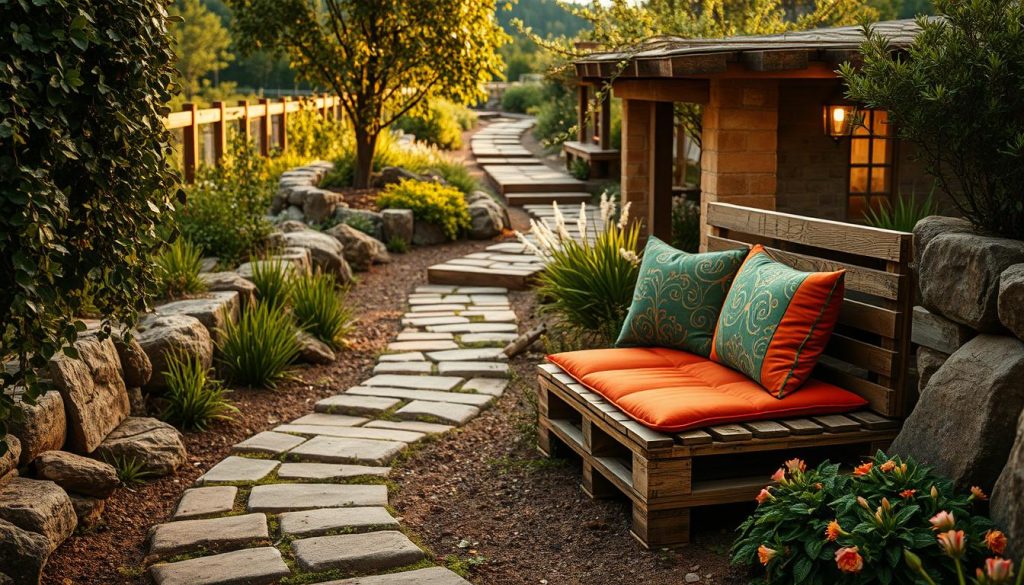
Old concrete slabs, or “urbanite,” are a free option. Break them up and use them like flagstone. Paint or stain them for color, or leave them natural for an aged look.
Glass Bottle Pathways
Wine and beer bottles can make magical pathways when buried in concrete or sand. Place them upside down in a trench. Make sure they’re secure and smooth.
Use different colored bottles to catch sunlight and create colorful shadows. This adds beauty to your garden.
Building Retaining Walls with Repurposed Items
Retaining walls from recycled materials add function and beauty to sloped gardens. Old tires filled with soil make sturdy walls. Plant trailing flowers to soften their look.
Concrete blocks from demolition sites are great for walls. Stack them and secure them well. Gabion cages filled with stones or glass bottles also work well. They drain well and look striking.
Building retaining walls safely is key. Make sure they drain well and don’t get too tall. For walls over three feet, get a pro’s advice.
Water Features Using Salvaged Elements
Water features bring life and calm to gardens. Use recycled materials like vintage bathtubs or sinks for ponds. Old ceramic pots with pumps make great small water features.
Repurposed industrial containers like metal troughs or wooden barrels also work. Make sure they’re sealed and stable. Add a pump to keep water moving and prevent mosquitoes.
Choose materials that won’t leach harmful chemicals. Clean them well and seal them safely. Add native plants to keep water clean and support wildlife.
Overcoming Challenges in Recycled Gardening
Recycled gardening has many benefits, but it also comes with challenges. You might face resistance from neighbors, safety issues, or limited materials. Knowing these challenges helps you find solutions and keep your green vision alive.
Addressing Aesthetic Concerns
Some worry that using recycled materials will make their garden look messy. The key is to use colors that work well together. Paint different containers in matching colors or group similar items to make a statement.
Where you place these items is also important. Arrange them thoughtfully, not randomly. Adding a finish, like sanding or sealing, can make them look great and win over your neighbors.
Ensuring Structural Integrity and Safety
Repurposed items weren’t made for gardens, so they might not be strong enough. Check if they can hold weight and if they’ll last in the weather. Things that get wet or are in the dirt can break down quickly.
Make sure to add support where needed. Use bracing on pallets, secure metal, and anchor tall items to the ground. For big projects, like walls or raised beds, get help from experts to keep things safe.
Dealing with Material Limitations
Working with recycled materials means you have to be flexible. You might not find exactly what you want. Keep a list of what you have and think of many ways to use each item.
Don’t be afraid to mix recycled items with new ones. This way, you can still be green while getting what you need. Sustainable gardening is about making progress, not being perfect.
Start Your Sustainable Garden Journey Today: From Trash to Garden Treasure
Ready to make your outdoor space greener? Start with a small project. Grab that old wooden crate or empty plastic bottles before you throw them away. They can kickstart your journey to zero-waste gardening.
First, pick a spot in your garage or shed for collecting garden materials. Store broken items or empty cans there until you get an idea. This habit will help you reuse creatively for years.
Begin with something simple like turning an old bucket into a planter. Or make a compost bin from wooden pallets. As you get more confident, you’ll tackle bigger projects like raised beds or water features.
Creating organic compost from kitchen scraps is a great addition. It’s a closed-loop system that feeds your plants and follows green living principles.
Sustainable gardening is a journey, not a finish line. Each season offers new chances to use found objects in your garden. Seeing your garden thrive from recycled materials is incredibly rewarding.
Begin today with what you already have. Your creativity and dedication to sustainability will turn trash into beautiful garden features. These will not only enhance your garden but also help our planet.

